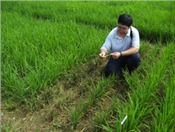|
Previously Unknown Rice Blast Resistance Isolated

Testing for rice blast resistance in genetically engineered rice plants is done in various countries.
Plant molecular pathologist Yulin Jia samples a field in Columbia for the disease.
Photo by Fernando Correa
BELTSVILLE, MD.
A never-before-described gene that gives rice resistance to a disease that has been costing about $66 billion a year in global damage has been isolated by a team of scientists led by Agricultural Research Service (ARS) plant pathologist Yulin Jia.
Rice blast, caused by the fungus Magnaporthe oryzae, results in annual yield losses large enough to have fed 60 billion people each year, according to the team’s paper just published in the journal Nature Communications.
In the United States’ mid-south rice-growing region, the cost of mitigating rice blast infection with fungicide applications can reach almost $20 per acre; plus, the fungus may still cause significant yield loss depending on the susceptibility of each rice variety and the degree of infection at the time of fungicide application, according to the U.S. Department of Agriculture's (USDA) Economic Research Service.
Amazingly, Ptr, the disease resistance gene Jia and his team found, has a structure that has not been seen in plants before. It has been previously deployed unknowingly in blast-resistant rice cultivars because it has been tightly linked to another disease resistance gene, Pi-ta, which has a genetic structure that is well-described in scientific literature.
Ptr has essentially been living in the shadow of Pi-ta. “Our research was able to separate the two genes and demonstrate that Ptr is independently responsible for its own broad-spectrum blast resistance without Pi-ta,” says Jia. “This will provide a new strategy for developing blast-resistant rice cultivars.” The full genomic sequence of the Ptr gene was put into GenBank for use by public researchers worldwide.
Jia, along with his colleagues Haijun Zhao, Melissa H. Jia and Jeremy D. Edwards, is with the ARS Dale Bumpers National Rice Research Center in Stuttgart, Arkansas. Other contributors include Xueyan Wang and Yeshi Wamishe at the University of Arkansas Rice Research and Extension Center (Stuttgart, Arkansas); Bastian Minkenberg, Matthew Wheatly and Yinong Yang at the Pennsylvania State University (University Park, Pennsylvania); Jiangbo Fan and Guo-Liang Wang at the Ohio State University (Columbus, Ohio); Adam Famoso at Louisiana State University (Rayne, Louisiana); and Barbara Valent at Kansas State University (Manhattan, Kansas). ∆
|
|